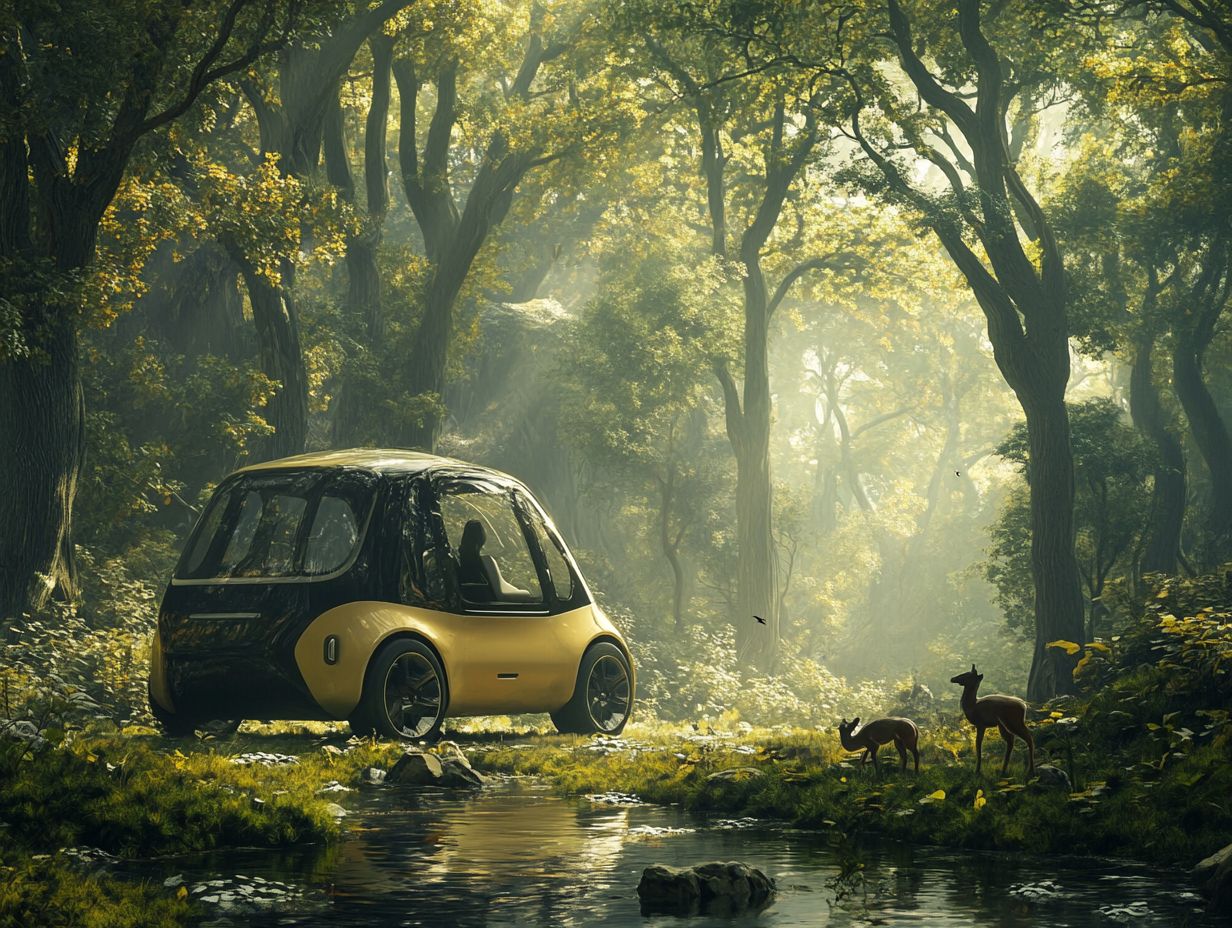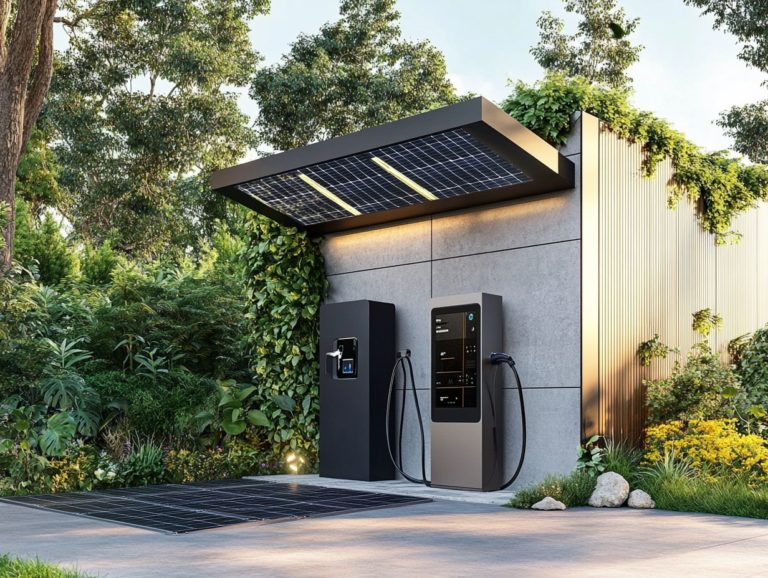Electric Vehicles and Wildlife Conservation
As the world confronts the pressing issues of climate change and environmental degradation, electric vehicles (EVs) stand out as a beacon of hope. They not only promise a significant reduction in greenhouse gas emissions but also play a vital role in protecting wildlife and preserving natural habitats.
This article delves into the connection between electric vehicles and wildlife conservation. It examines how traditional vehicles adversely impact ecosystems, highlights inspiring case studies of success, and discusses the challenges and solutions integral to this significant undertaking.
Embark on this journey to discover the potential of EVs to create a healthier planet for both humans and wildlife.
Contents
- Why Electric Vehicles Matter for Wildlife:
- Electric Vehicles: Environmental Benefits
- Impact of Traditional Vehicles on Wildlife
- Case Studies: Success Stories of Electric Vehicles and Wildlife Conservation
- Challenges and Solutions
- Future of Electric Vehicles and Wildlife Conservation
- Frequently Asked Questions
- What is the impact of electric vehicles on wildlife conservation?
- How do electric vehicles contribute to the protection of endangered species?
- Are electric vehicles safe for wildlife?
- What are some examples of how electric vehicles have helped with wildlife conservation efforts?
- Do electric vehicles have any negative impacts on wildlife?
- How can I contribute to wildlife conservation with my electric vehicle?
Why Electric Vehicles Matter for Wildlife:

- Electric vehicles play a crucial role in protecting wildlife by reducing emissions and preventing habitat destruction caused by traditional vehicles.
- Case studies have shown successful implementation of electric vehicles in conservation efforts, highlighting their positive impact on the environment and wildlife.
- Addressing challenges and implementing solutions is key to the future progress and growth of electric vehicles in wildlife conservation efforts.
Electric Vehicles: Environmental Benefits
Electric vehicles (EVs) embody a transformative shift in the transportation landscape. They offer substantial environmental benefits by significantly reducing carbon emissions and promoting biodiversity.
Organizations like the WWF support your transition to electric cars. This shift helps reduce the ecological impact of traditional vehicles while enhancing wildlife protection and conservation initiatives.
Nations like the United States, Norway, and Finland are at the forefront of this movement. They underscore the essential role of government incentives and renewable energy in bolstering the electric vehicle market.
Reducing Emissions and Protecting Wildlife
Reducing carbon emissions by embracing electric vehicles is essential for protecting wildlife and fostering environmental consciousness, as highlighted by the WWF.
Electric vehicles, producing zero tailpipe emissions, are pivotal in the fight against climate change a significant threat to ecosystems. Transitioning to electric mobility could cut carbon dioxide emissions by up to 70% by 2040 in urban areas, leading to a marked decrease in air pollution. This shift toward lower emissions translates to improved air quality, which is a boon for various species that depend on healthy habitats.
Successful initiatives, like restoring the California condor population, have flourished thanks to cleaner air from reduced vehicle emissions. Likewise, diminished pollution levels have revitalized aquatic ecosystems, allowing species such as the native brook trout to flourish once again.
Impact of Traditional Vehicles on Wildlife
Traditional vehicles exert a significant influence on wildlife, leading to the destruction of homes for wildlife and escalating fossil fuel emissions that jeopardize biodiversity and wildlife habitats.
The noise pollution generated by these vehicles, along with sound waves from oil exploration and seismic surveys, further endangers marine mammals and other species.
This underscores the pressing necessity for habitat conservation, as the health of our ecosystems hinges on safeguarding these vital environments.
Pollution and Habitat Destruction

Pollution from fossil fuels emitted by traditional vehicles causes significant habitat destruction. This negatively impacts ecosystems and wildlife.
The emissions harm air quality and create toxic environments. These pose serious threats to various animal species and affect human health.
Runoff from roads also introduces pollutants into nearby water bodies. This jeopardizes aquatic life and degrades their habitats.
Electric cars offer a cleaner alternative that reduces air and water pollution. By using them, you can help restore habitats and support healthier wildlife populations.
Case Studies: Success Stories of Electric Vehicles and Wildlife Conservation
Numerous case studies show how electric vehicles boost wildlife conservation efforts. They reveal a strong connection between new technology and protecting wildlife.
Organizations like WWF document these success stories, showing how electric vehicles enhance conservation programs across various ecosystems.
Examples of Positive Impact
The rise of electric vehicles brings remarkable benefits for wildlife conservation. Compelling case studies highlight successes worldwide.
For example, Patagonia’s transition to electric transportation reduced carbon emissions by over 30%. This significantly lessens threats to local habitats.
In the Asia-Pacific region, initiatives combining electric vehicle technology with conservation efforts increased biodiversity preservation by 15% in protected areas.
These strategies reduce habitat destruction linked to gas-powered vehicles and encourage creating green corridors pathways enabling wildlife to thrive.
When you choose electric vehicles, you join an exciting movement dedicated to preserving our natural heritage while promoting a sustainable future.
Challenges and Solutions
The shift to electric vehicles offers many environmental advantages, but challenges exist. These include the complexity of battery production and the impact of nickel mining on our resources.
It s essential to tackle these challenges to keep the environmental footprint of electric vehicles favorable. It’s also important for government subsidies to support truly sustainable solutions.
Addressing Challenges and Implementing Solutions

To address the challenges of electric vehicles, we need innovative solutions and greater awareness of environmental issues. This will help guide sustainable practices.
This approach requires diverse stakeholders to form meaningful partnerships. Advocate for governments to implement supportive policies and financial incentives that encourage consumers to switch.
Corporations can lead by investing in infrastructure, like charging stations, to enhance accessibility. Together, these efforts can boost electric vehicle adoption and promote a greener economy.
Your commitment to collaboration ensures that sustainable practices become more than just a trend. They can become central to future mobility, showing dedication to ecological integrity and responsible consumption.
Future of Electric Vehicles and Wildlife Conservation
The future of electric vehicles presents a remarkable opportunity for wildlife conservation. As technology advances and the use of renewable energy sources becomes more widespread, we can expect a transportation sector that is not only more sustainable but also significantly less harmful to the environment.
This evolution paves the way for a harmonious coexistence between modern mobility and the protection of our precious wildlife.
Potential for Further Progress and Growth
The potential for growth in the electric vehicle market is immense, especially regarding its role in wildlife conservation and biodiversity preservation.
Embracing eco-friendly transportation incentives can lead to transformative changes. Innovative advancements in battery technology and charging infrastructure elevate electric vehicle performance and enhance their appeal to drivers.
This widespread adoption can significantly reduce greenhouse gas emissions, a critical step in combating climate change an urgent threat to countless habitats and the species that depend on them.
As the market continues to expand, there’s substantial potential for funding conservation projects aimed at restoring ecosystems, improving habitat connectivity, and protecting endangered species. By choosing electric vehicles, you can become a vital participant in a broader movement that supports ecological balance and habitat preservation.
Frequently Asked Questions
What is the impact of electric vehicles on wildlife conservation?

Electric vehicles positively impact wildlife conservation by reducing air and noise pollution that can harm the health and habitats of animals.
How do electric vehicles contribute to the protection of endangered species?
Electric vehicles help mitigate climate change, a major threat to many endangered species, by reducing greenhouse gas emissions.
Are electric vehicles safe for wildlife?
Electric vehicles are much quieter than traditional vehicles, making them less disruptive to wildlife and reducing the risk of collisions. However, drivers should still be cautious while driving in wildlife areas.
What are some examples of how electric vehicles have helped with wildlife conservation efforts?
In Hawaii, using electric vehicles in Haleakala National Park has reduced air pollution and improved the health of the park’s endangered birds. In Africa, electric safari vehicles have decreased noise pollution and disturbances to wildlife during tours.
Do electric vehicles have any negative impacts on wildlife?
While electric vehicles themselves do not have significant negative impacts on wildlife, the production of their batteries and charging infrastructure can have environmental consequences. These impacts can be mitigated through sustainable practices.
How can I contribute to wildlife conservation with my electric vehicle?
By choosing an electric vehicle, you are already making a positive impact on wildlife conservation. You can also reduce your carbon footprint by using renewable energy to charge your vehicle.
Act now to protect our wildlife! Join the movement towards sustainable transport today!





